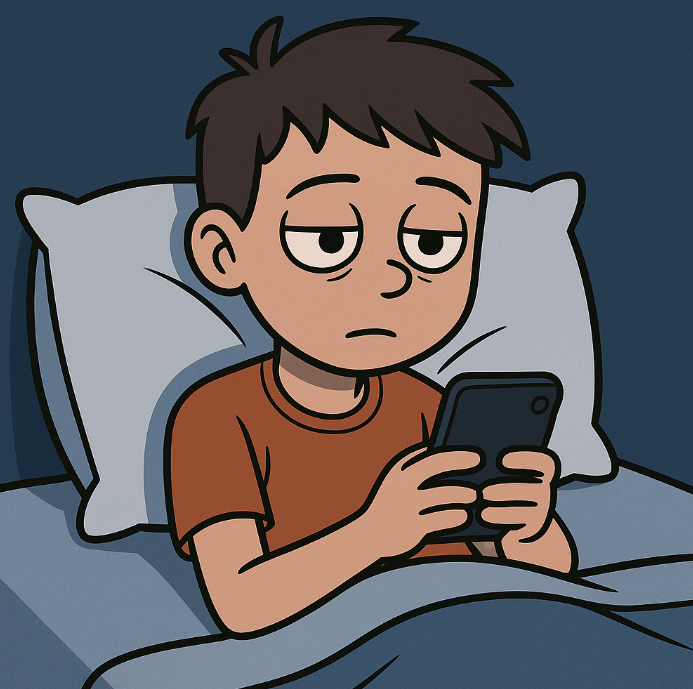
The Impact of Bed Rot
A middle schooler sits at her desk, eyes glazed. The teacher has just explained a math concept for the third time, but her mind drifts back to the video she saw last night.
Fifteen seconds of flashing edits, a trending dance, a quick laugh. The classroom feels too slow, too quiet. Her pencil hovers, but the urge to check her phone itches stronger than the problem on the page.
Sound familiar? This isn’t laziness. It’s not defiance. It’s what researchers are now calling “brain rot”—the creeping impact of too much short-form content on kids’ attention, memory, and motivation. And it’s paired with another trend that parents whisper about but teens openly joke about online: “bed rot.” Hours lying in bed, scrolling endlessly, until sleep, exercise, and even meals take a backseat.
These aren’t just internet buzzwords. They’re red flags waving at schools and families everywhere.
What the Science Says
Recent studies paint a sobering picture:
- Shrinking Attention Spans: Brain scans show that heavy social media use is linked to reduced prefrontal cortex density—the part of the brain responsible for decision-making and focus. Translation? Kids literally have a harder time staying on task.
- Academic Fallout: Students absorbed in short-form content retain 30% less information and show real GPA declines compared to peers. The quick-hit dopamine loops of TikTok or YouTube Shorts make a worksheet or a chapter book feel like running a marathon.
- Procrastination Spiral: Why tackle that essay when a perfectly engineered distraction sits in your pocket? Researchers call it the “shallow thinking trap”: brains conditioned for easy wins avoid hard work. The result? Skyrocketing procrastination rates and lower-quality learning.
- Mental Health Toll: “Bed rot” isn’t just laziness. It’s linked to increased depression, anxiety, and poor sleep. Blue light from late-night scrolling wrecks circadian rhythms, while constant comparison to curated online lives chips away at self-esteem.
Put simply: the apps are winning.
Why It Hits Kids So Hard
Children and adolescents are in a period of intense brain plasticity. Their neural pathways are still wiring up, which makes them especially vulnerable to digital habits. Think of it like wet cement: repeated swipes and quick dopamine hits carve grooves that shape how kids think, focus, and feel for years to come.
And schools? They’re left playing catch-up. Teachers face classrooms where even the most engaging lesson competes with the memory of a 7-second meme. Parents battle bedtime routines where “lights out” doesn’t mean “screens off.”
A Wake-Up Call for Schools and Families
So what do we do? The good news: researchers aren’t just diagnosing the problem—they’re suggesting interventions.
For Parents
- Screen Time with Purpose: Replace the endless scroll with interactive, creative digital activities: coding games, art apps, or even co-watching videos and talking about them.
- Bedtime Boundaries: Keep phones out of bedrooms at night. Sleep hygiene is mental health hygiene.
- Model Balance: Kids notice if parents are glued to screens too. Shared screen-free routines, like family dinners, set a powerful precedent.
For Schools
- No-Phone Zones: Classrooms free of constant buzzing give kids a fighting chance to focus.
- Teach Digital Literacy: Equip students to understand how algorithms manipulate attention and why it matters.
- Promote Deep Work: Structured approaches like the Pomodoro Technique can help refocus attention during the school day.
For Everyone
- Get Moving: Physical activity is the antidote to both brain and bed rot. Exercise not only boosts mood but restores attention capacity.
- Mindfulness Moments: Short breathing or grounding exercises during class transitions can help students recalibrate overstimulated brains.
Why This Matters Now
Left unchecked, these patterns risk producing a generation struggling with attention, problem-solving, and resilience. And it’s not just about school performance—it’s about kids’ futures in a world that requires creativity, focus, and collaboration.
But there’s hope. With parents, educators, and policymakers working together, we can reshape this narrative. We can equip kids to navigate the digital world without being consumed by it.
Let’s Talk About It
Your voice matters in this conversation. Let’s spark change by sharing and learning from each other.
- What’s the biggest mental health challenge you see in schools today?
- How can schools better support students’ emotional well-being?
- What’s one psychology insight that changed the way you parent or teach?
Drop your thoughts in the comments or share this post with your community. Because tackling brain rot and bed rot isn’t just about kids’ grades—it’s about their futures.



